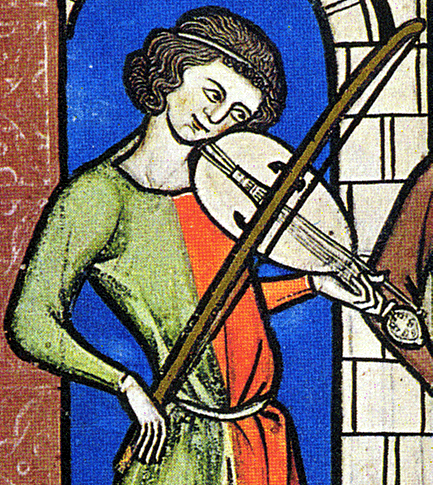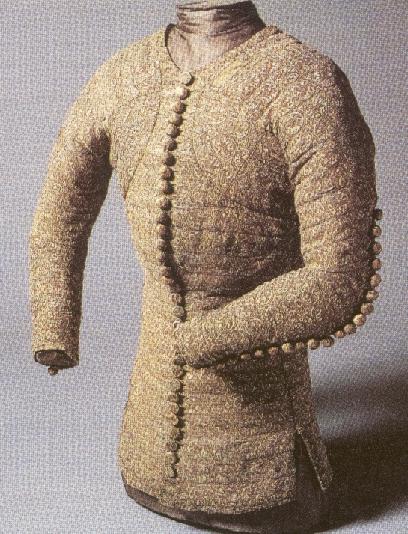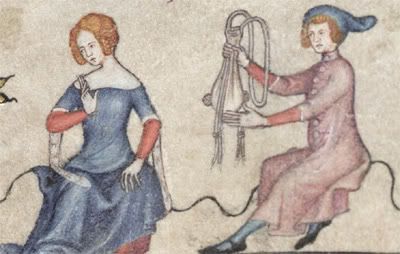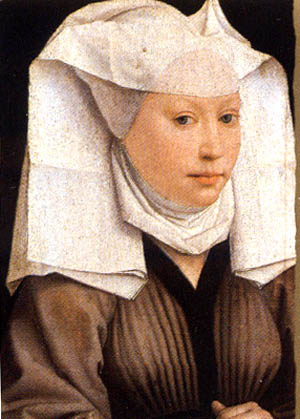Values:
• Christianity - God's will
• Chivalry
• Heirarchy
Women
• oppressed and owned
• lacking a soul
• chattel
• objects of chivalry
Resources:
• primarily wool
• velvets, brocades and silks for upper classes
•rough wools and linens for lower classes
• fur for everyone!
Notable Events:
• the dark ages
• Emperor Charlemagne
• feudalism
• 11th century cultural revival
• capture of Constantinople
• emergence of the bourgeoisie - 13th century
• The Black Death - 1348-50
• The Hundred Years war - 1337-1453
• The Printing Press - 1450's
Men
• the rise to kighthood
Costume
• long and flowing
• layered
• warm fabrics
• discovery of buttons
• the rise of the tailor
Jewelry
• simple, gold
Footwear
• Pointy! Rise of the poulaine
Grooming
• less bathing
• paint as rouge
• honey on lips
• thin plucked, arched eyebrow - and hairline!
• long hair for men and women
• women wore hair in plaits, braids or buns, also long and flowing
Headdresses
• hoods, hats and caps for men
• hairnet or crespine for women
• veils and wimples
• high hats with veils (henin)
Gothic Costume History
The costumes of Gothic time are usually divided into two periods: Early Gothic and Late Gothic. The costumes of the Early Gothic (1200-1350) period are more elegant, more sophisticated and simpler in cut than the Romanesque period. Necklines were lower, a little at first and trimming was not so heavy as before. The heavy double-sleeve went out by 1200 and the forearm was revealed because sleeves became tight.
Shorter tunics emerged and the cote-hardie reached to the knee and a little above it but women's clothing was invariably long. Late Gothic periods that range from 1350-1450 and styles changed relatively quickly during this time. The period changed from the earlier flowing draperies that metamorphosed, finally, into fabrics that became more and more stiff. In the fifteenth century the extremes were in mostly the upper silhouette. There were crisp pleats, tight belts, padded doublets, and increasingly popular leg-o-mutton sleeve, all the items foreshadowing the squareness of the next hundred years.
In the early Gothic period men wore hair at a pleasant and sensible length often in a bob to the jaw line with a bang across the forehead. Blond hair was popular so many people bleached their hair. Few men wore beards and if they did they were trimmed into two points. Men in the late Gothic period wore hair bobbed also with neatly curled ends and more men began wearing beards that were neatly trimmed accompanied by a small mustache. Later in the period they would wear their hair cropped much like the modern manner of men's hair.
Women in the both periods wore their hair loose and flowing upon their shoulders until they were married where they hair was confined in a bun at the nape. In the early period women would wear many types of hair pieces to cover it, such as wimple and gorget. The gorget would actually cover the neck while the wimple would cover the head. Later in the period women's necks were exposed but their hair was covered by netting or reticulations like round cages. Nor hair was visible and was plucked to have a high hairline and thin eyebrows.
Colors for this period are jewel like hues much like painting from Jan van Eyke's work. The colors were reds, greens, blues and golds, soft but intense. Interspersed with these colors were brown gray and tan of humbler garments. One particular color that you could associate with the earlier period would be vermillion.
Notable Gothic Costume Elements
| Heraldry—A combination of particoloring, coat of arms and family insignia that would note family lineage in coat of arms or clothing. | |||
| Parti-coloring—A multi-colored garment, often with one side embroidered based on the colors and the emblems in a coat of arms. | |||
| Chaperon—A caped hood with long tail, or liripipe, worn with the face opening around the head and the liripipe wound about the head and then draped under the chin. | |||
| Doublet—A short jacket or variety of pourpoint sleeved or sleeveless, worn under a closefitting pourpoint, when used as an outer garment it was padded and had a short skirt. | |||
| Pourpoint—A short jacket with tight sleeves buttoned from elbow to wrist, worn under the cote-hardie; formerly known as a paltock. | |||
| Cote-hardie—A shaped garment, tight-fitting around the shoulder, waist and hips. When worn by a woman it usually ended at the hips or slightly below, often with dagged or scalloped edges. It could be hooked or laced up either the front or the back. | |||
| Tippet—A band sewn around the elbow of the cote-hardie sleeve with the end hanging as a streamer. | |||
| Houppelande—A loose and comfortable gown of great size introduced during the reign of Charles VI in France which became very fashionable during the reign of Richard II in England. One style worn by men had long, flowing , bell shaped sleeves, a long fitted waist, and floor length or long skirt slit to the knees; another style, known as the bastard houppelande was only to calf length. A high standing collar was usually a part of this flamboyant costume. The woman's version of this robe had a soft, open collar, a short waist, a full skirt, and a long flowing sleeves. | |||
| Hennin—A truncated cone or steeple headdress with a veil completely covering the female hairdo. | |||
| Points—Metal tipped ribbons or lacings sewed in corresponding pairs to sleeves and armseyes or to doublet and hose. | |||
Poulaines/Crackows—A long-tipped hose and shoe introduced during the reign of Richard II and named after the city of Crackow in Poland; later the length of the toe became so long it had to be tied to the knee. | |||
| Reticulation—Decorative metal cages which confined the hair at the side of a woman's head. | |||
| Escoffin—As tall, richly brocaded headdress, sometimes shaped like two horns, sometimes like a narrow, tall turban; usually had a veil of fine lawn about a yard wide. | |||
|
Gorget—A wimple or cover-chief worn under the chin and tucked under the neckline of the gown. | |||
Dagging—Scallops, crosses and points that would decorate the edge of the fabric and functionally would finish the edges. | |||
| Pomander—A ball or hollow ornament often made of filigree, containing a sponge of perfume, suspended from a necklace or girdle. | |||
| Tabard—Square piece of fabric with a hole in the middle, to be worn over the armor. | |||
| Sideless Surcote—A woman's over-gown cut away at the sides from under the arms to the hips to show the cote-hardie or kirtle underneath; it was usually worn with a plastron at the front of the figure. It remained as a ceremonial dress for women during the latter of this period. | |||
Coif—A close fitting cap tied under the chin. | |||
| Sugar Loaf - Men's hat. Made of felt in the shape of a sugar loaf. | |||
Homework: Do a plate featuring the costumes of a woman and a man from the Middle Ages. You may choose to do either a mood board, a photograph, or an illustration. It should be accompanied by a paragraph about clothing from the middle ages. |

























No comments:
Post a Comment